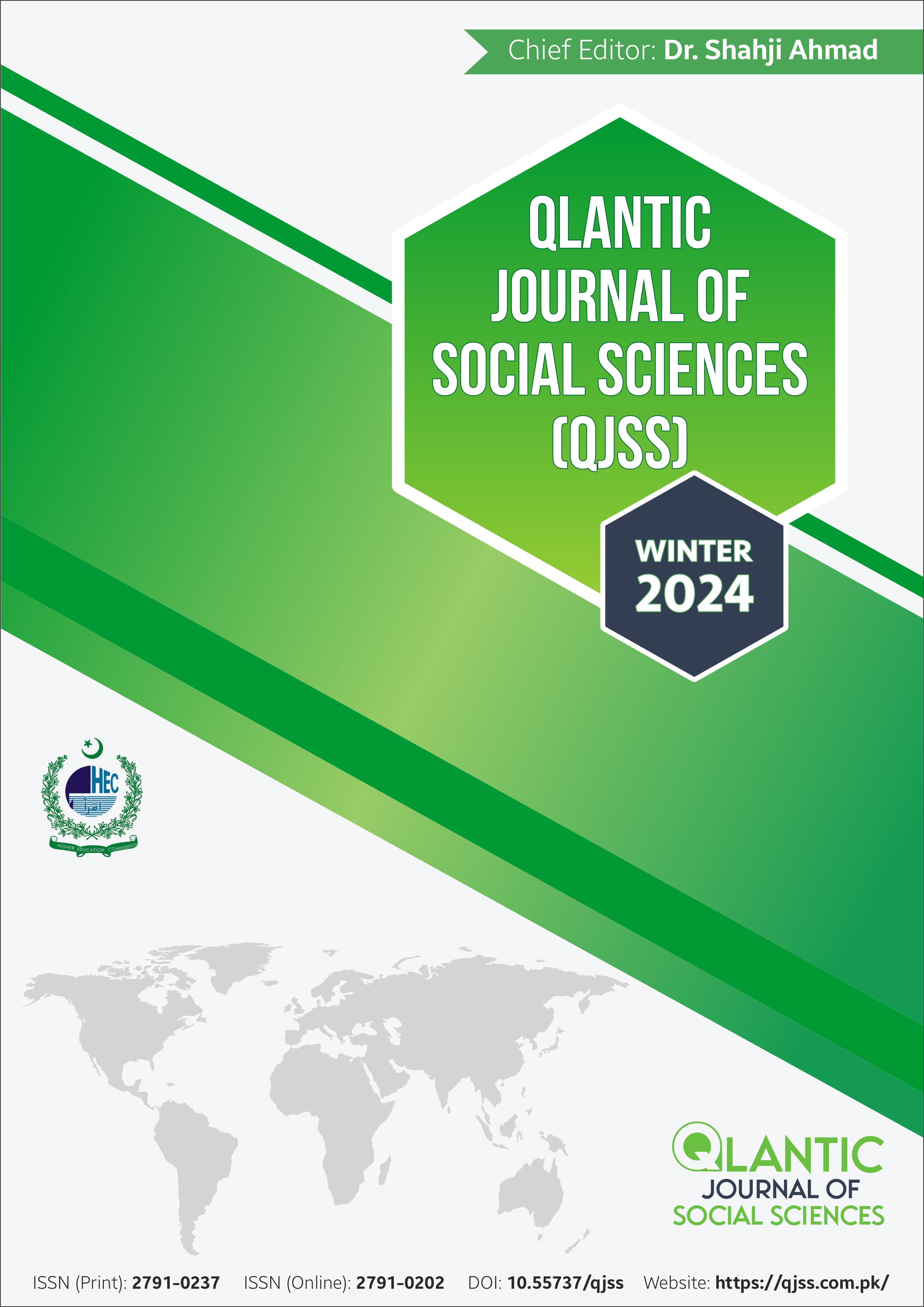Fear of Negative Evaluation, Appearance Distress and Inferiority Complex among University Women Having Acne Problem
DOI:
https://doi.org/10.55737/qjss.915349311Keywords:
Fear of Negative Evaluation, nferiority Complex, Appearance Distress, Social Anxiety TheoryAbstract
This study was designed to investigate the relationship between fear of negative evaluation and inferiority complex in university women with acne problems. Study also explored the mediating role of appearance distress between the variables. A correlational survey research designed was employed to execute the research. Data was collected through purposive sampling and the sample was of university women (n= 220) with acne problem. The tools for the study were ‘Brief Version of the Fear of Negative Evaluation Scale (Leary,1983), Appearance Anxiety Inventory Scale (David Veale, 2011), COMPIN Scale (Djordje Ceklija, 2017) for Inferiority Complex. For data analysis, Partial least square-structural equation modelling (PLS-SEM) was applied via statistical software, i.e. Smart-PLS (version-4 M4). The measurement model showed high reliability and validity and the structural model revealed positive and significant direct and indirect effect of appearance distress between the fear of negative evaluation and inferiority complex among women having acne problem. Practical and societal implications have been discussed for the women having acne, counselors and clinicians.
References
Adler, A. (1927). Individual psychology. The Journal of Abnormal and Social Psychology, 22(2), 116-122. https://doi.org/10.1037/h0072190
Bagatin, E., Freitas, T. H., Rivitti-Machado, M. C., Ribeiro, B. M., Nunes, S., & Rocha, M. A. (2019). Adult female acne: A guide to clinical practice. Anais Brasileiros de Dermatologia, 94(1), 62-75. https://doi.org/10.1590/abd1806-4841.20198203
Cash, T. F., & Fleming, E. C. (2002). The impact of body image experiences: Development of the body image quality of life inventory. International Journal of Eating Disorders, 31(4), 455-460. https://doi.org/10.1002/eat.10033
Čekrlija, Đ., Đurić, D., & Mirković, B. (2017). Validation of Adlerian inferiority (COMPIN) and superiority (SUCOMP) complex shortened scales. Civitas, 7(2), 13-35. https://doi.org/10.5937/civitas1701013c
Chang, S. (2023). Chinese women, marriage and gender: exploring the idea of women and marriage over time in the context of china.
Clark, D. M., and Wells, A. (1995). “A cognitive model” in Social Phobia: Diagnosis, Assessment, and Treatment. Ed. R. G. Heimberg (New York, NY, USA: The Guilford Press), 69–93.
Duru, P., & Örsal, Ö. (2021). The effect of acne on quality of life, social appearance anxiety, and use of conventional, complementary, and alternative treatments. Complementary Therapies in Medicine, 56, 102614. https://doi.org/10.1016/j.ctim.2020.102614
Dudek, J. E., Białaszek, W., Ostaszewski, P., & Smidt, T. (2018). Depression and appearance-related distress in functioning with lipedema. Psychology, Health & Medicine, 23(7), 846-853. https://doi.org/10.1080/13548506.2018.1459750
Fornell, C., & Larcker, D. F. (1981). Structural equation models with unobservable variables and measurement error: Algebra and statistics. Journal of Marketing Research, 18(3), 382-388. https://doi.org/10.1177/002224378101800313
Gallitano, S., & Berson, D. (2018). How acne bumps cause the blues: The influence of acne vulgaris on self-esteem. International Journal of Women's Dermatology, 4(1), 12-17. https://doi.org/10.1016/j.ijwd.2017.10.004
Hofmann, S. G. (2007). Cognitive factors that maintain social anxiety disorder: A comprehensive model and its treatment implications. Cognitive Behaviour Therapy, 36(4), 193-209. https://doi.org/10.1080/16506070701421313
Henseler, J., Ringle, C. M., & Sarstedt, M. (2014). A new criterion for assessing discriminant validity in variance-based structural equation modeling. Journal of the Academy of Marketing Science, 43(1), 115-135. https://doi.org/10.1007/s11747-014-0403-8
Hair Jr., J. F., Matthews, L. M., Matthews, R. L., & Sarstedt, M. (2017). PLS-SEM or CB-SEM: Updated guidelines on which method to use. International Journal of Multivariate Data Analysis, 1(2), 107. https://doi.org/10.1504/ijmda.2017.10008574
Hair, J. F., Hult, G. T. M., Ringle, C. M., & Sarstedt, M. (2014). A primer on partial least squares structural equation modeling (PLS-SEM).
Johan, W. P., Herdiansyah, H., & DIMYATI, D. (2022). The correlation between inferiority complex and social interactions in adolescents. Makna: Jurnal Kajian Komunikasi, Bahasa, dan Budaya, 11(2), 42-56. https://doi.org/10.33558/makna.v11i2.4435
Jia, Y., Xue, Y., & Wang, X. (2022). Self-efficacy and negative silence in the classroom: The mediating role of fear of negative evaluation. Nurse Education in Practice, 62, 103379. https://doi.org/10.1016/j.nepr.2022.103379
Leary, M. R. (1983). A brief version of the fear of negative evaluation scale. Personality and Social Psychology Bulletin, 9(3), 371-375. https://doi.org/10.1177/0146167283093007
Magin, P. (2004). A systematic review of the evidence for 'myths and misconceptions' in acne management: Diet, face-washing and sunlight. Family Practice, 22(1), 62-70. https://doi.org/10.1093/fampra/cmh715
Øverup, C. S., Strizzi, J. M., Cipric, A., Træen, B., & Hald, G. M. (2021). Appearance satisfaction as a predictor of specific sexual problems and associated distress. The Journal of Sexual Medicine, 18(9), 1532-1544. https://doi.org/10.1016/j.jsxm.2021.06.019
Paganini, A., Persson, M., & Mark, H. (2021). Influence of gender, dispositional optimism, and coping strategies on appearance-related distress among Swedish adults with cleft lip and palate. The Cleft Palate-Craniofacial Journal, 59(6), 715-723. https://doi.org/10.1177/10556656211025196
Rapee, R. M., & Heimberg, R. G. (1997). A cognitive-behavioral model of anxiety in social phobia. Behaviour Research and Therapy, 35(8), 741-756. https://doi.org/10.1016/s0005-7967(97)00022-3
Rumsey, N., & Harcourt, D. (2007). Visible difference amongst children and adolescents: Issues and interventions. Developmental Neurorehabilitation, 10(2), 113-123. https://doi.org/10.1080/13638490701217396
Stopa, L., & Clark, D. M. (1993). Cognitive processes in social phobia. Behaviour Research and Therapy, 31(3), 255-267. https://doi.org/10.1016/0005-7967(93)90024-o
Tang, S. (2012). A review of researches on inferiority complex at home and abroad (in Chinese). Intelligence, 187–188.
Veale, D., Eshkevari, E., Kanakam, N., Ellison, N., Costa, A., & Werner, T. (2013). The appearance anxiety inventory: Validation of a process measure in the treatment of body dysmorphic disorder. Behavioural and Cognitive Psychotherapy, 42(5), 605-616. https://doi.org/10.1017/s1352465813000556
Verma, K., & Kaushik, P. (2017). Social appearance anxiety and fear of negative evaluation in college going students with acne vulgaris. International Journal of Psychology and Psychiatry, 5(2), 63. https://doi.org/10.5958/2320-6233.2017.00011.6
Watson, D., & Friend, R. (1969). Measurement of social-evaluative anxiety. Journal of Consulting and Clinical Psychology, 33(4), 448-457. https://doi.org/10.1037/h0027806
Yang, J., Yang, H., Xu, A., & He, L. (2020). A review of advancement on influencing factors of acne: An emphasis on environment characteristics. Frontiers in Public Health, 8. https://doi.org/10.3389/fpubh.2020.00450




